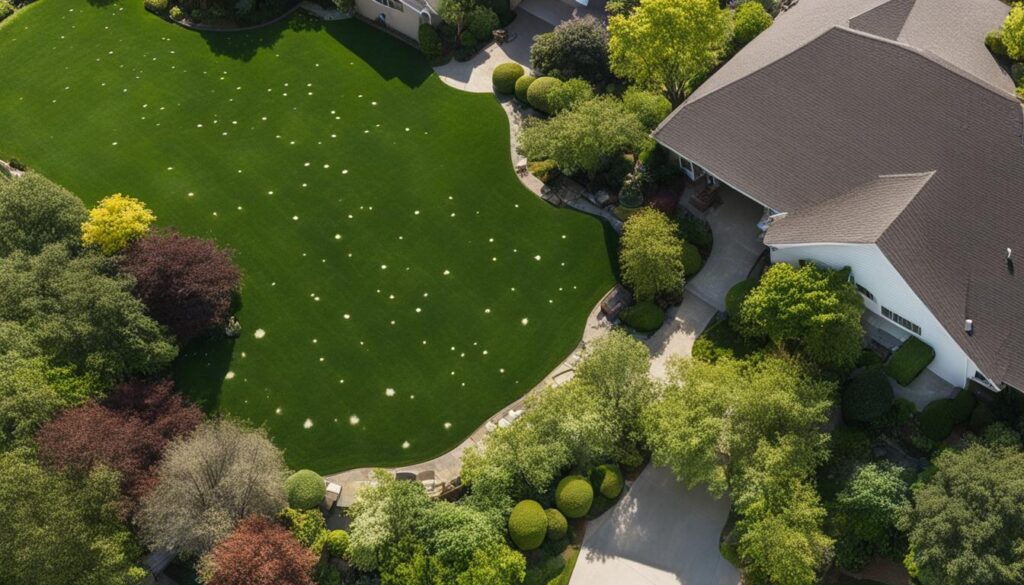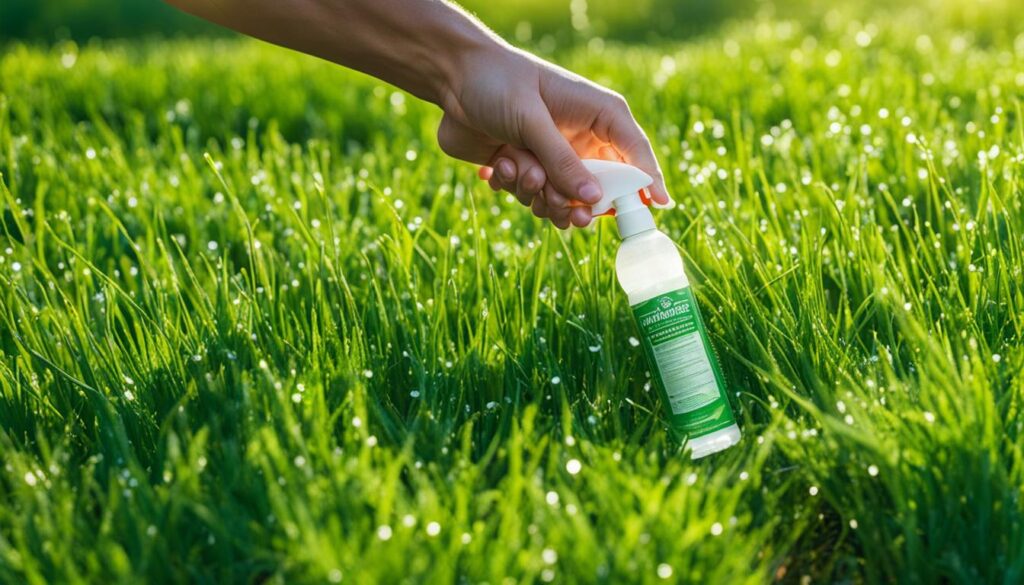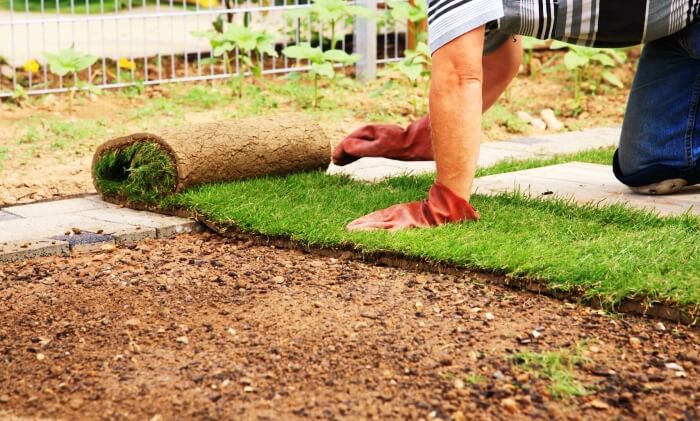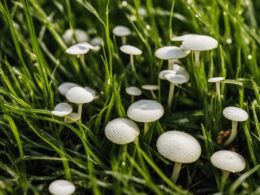If you’re a homeowner who takes pride in your lawn, seeing white spots on your grass can be frustrating. These spots are often caused by a fungal infection known as powdery mildew. Powdery mildew is a common problem in Maryland lawns, especially on cool-season grasses like tall fescue and Kentucky bluegrass. It typically appears in shaded areas with high humidity and poor air circulation, making your lawn look unsightly and stressed.
The good news is that you can treat and prevent powdery mildew, restoring your lawn’s lush green beauty. By understanding the causes, identifying the symptoms, and taking the right preventive measures, you can eliminate those white spots and have a healthy, vibrant lawn.
Key Takeaways:
- Powdery mildew on grass is caused by a fungal infection and appears as white, powdery growth on the grass blades.
- Shaded areas with high humidity and poor air circulation are favorable conditions for powdery mildew.
- Preventive measures such as improving airflow, reducing shade, and proper lawn care practices can help control and prevent powdery mildew.
- Regular monitoring, timely treatment, and consultation with a professional are essential for severe or persistent cases of powdery mildew.
- Restoring your lawn’s health and eliminating white spots on grass is possible with the right care and attention.
Identifying Powdery Mildew on Grass
Powdery mildew on grass can be easily identified by the presence of white, powdery growth on the surfaces of the grass blades. It typically starts as isolated patches that gradually spread and cover the entire blade if left untreated. Other symptoms may include the development of black fruiting bodies within the powdery masses and the yellowing or dying of severely infected grass. It’s important to correctly identify powdery mildew on grass to effectively treat and prevent its spread.
In the case of powdery mildew on grass, the key identifiable characteristic is the powdery white growth on the grass blades. This white powdery substance is actually a fungal development. The fungus forms spores that are easily transported by wind, spreading the infection further. As powdery mildew progresses, it can cause the grass to turn yellow or brown and, in severe cases, lead to the death of the grass.
The appearance of black fruiting bodies within the powdery masses is another telltale sign of powdery mildew. These fruiting bodies contain the reproductive structures of the fungus and contribute to the spread of the infection. If you notice these black structures amidst the white powdery growth on your grass, it is a clear indication of powdery mildew.
Furthermore, severely infected grass may exhibit significant yellowing or even entire patches dying off. This is a result of the fungus inhibiting the grass’s ability to carry out photosynthesis and obtain necessary nutrients. As a result, the grass becomes weakened, stressed, and more susceptible to other diseases and stressors.
By accurately identifying powdery mildew on your grass, you can take the necessary steps to treat and prevent its spread, ensuring the health and beauty of your lawn.
Causes of Powdery Mildew on Grass
Powdery mildew on grass is primarily caused by a fungal infection known as Blumeria graminis (formerly Erysiphe graminis). This fungus affects certain grass species, including tall fescue, Kentucky bluegrass, and Bermudagrass. These grass types are more susceptible to powdery mildew compared to others.
The development and spread of powdery mildew on grass are influenced by specific environmental conditions. The fungus thrives in areas with shade, poor air circulation, high humidity, and moderate temperatures ranging between 60 to 70 degrees Fahrenheit. These conditions create an ideal environment for the growth and multiplication of the powdery mildew fungus.
Additionally, excessive nitrogen fertilizer can contribute to the development of powdery mildew on grass. Overfertilization with nitrogen can cause the grass to grow rapidly and produce succulent foliage, which is susceptible to fungal attacks.
Understanding the causes of powdery mildew on grass is crucial for effective prevention and control measures. By addressing these underlying conditions, you can minimize the risk of powdery mildew and maintain a healthy, vibrant lawn.
Treating Powdery Mildew on Grass
When it comes to treating powdery mildew on your grass, there are several options to consider. Improving your lawn care practices is an effective approach to prevent and control the fungus. One important step is to avoid over- or under-watering, as powdery mildew thrives in moist conditions. Additionally, improving airflow through fall aeration and overseeding can help reduce humidity and create a healthier environment for your grass.
Providing your lawn with proper fertilization based on soil testing is another important aspect of treating powdery mildew. Balanced fertilization helps strengthen your grass and make it more resistant to fungal infections. By taking these preventive measures, you can significantly reduce the likelihood of powdery mildew spreading and causing damage to your lawn.
If you’re dealing with severe or persistent powdery mildew, considering fungicide treatments may be necessary. These specialized products are designed to target and eliminate the fungus, providing effective relief for your grass. Consulting a lawn care professional can help you determine the best treatment plan for your specific situation and ensure that you’re using the appropriate products and techniques.
Remember, treating powdery mildew on your grass is not a one-time fix. It requires consistent effort and proper maintenance to keep your lawn healthy and resistant to fungal infections. By implementing these treatment options and following proper lawn care practices, you can restore the vibrancy of your grass and enjoy a beautiful, disease-free lawn.
Preventing Powdery Mildew on Grass
Taking preventive measures is key to avoiding the recurrence of powdery mildew on grass. By implementing these preventative measures, you can keep your lawn healthy and resilient against powdery mildew. Here are some lawn care tips for powdery mildew prevention:
- Maintain Adequate Airflow: Ensure proper air circulation in your lawn by trimming overgrown trees and shrubs that may obstruct airflow. This can help reduce the humidity levels that powdery mildew thrives in.
- Reduce Shade: Powdery mildew prefers shady areas, so try to minimize the shade in your lawn by pruning trees or strategically placing shade-tolerant grass varieties.
- Water in the Morning: Water your lawn early in the morning to allow the grass to dry throughout the day. This helps prevent excessive moisture that can contribute to powdery mildew development.
- Avoid Heavy Nitrogen Applications: Excessive nitrogen fertilization can make your grass more susceptible to powdery mildew. Follow the recommended fertilization guidelines and conduct soil tests to determine the appropriate amount of nitrogen for your lawn.
- Overseed Shady Areas: If you have shady spots in your lawn, overseed them with mildew-resistant grass cultivars. These cultivars are more resistant to powdery mildew and can help prevent its spread.
- Improve Air Circulation: Prune or trim landscape plants to create better air circulation in your lawn. This can help reduce the humidity levels and prevent the development of powdery mildew.
By following these lawn care tips for powdery mildew prevention, you can maintain a beautiful and disease-free lawn. Keeping your grass healthy and preventing the recurrence of powdery mildew will ensure your lawn remains lush and vibrant.
Controlling Powdery Mildew in Lawns
When it comes to controlling powdery mildew in your lawns, a combination of cultural practices and possible fungicide treatments can effectively combat this fungal infection. By implementing the following tips, you can take charge of powdery mildew and restore the health of your lawn.
Firstly, it’s essential to open up the area and improve air circulation. This can be achieved by pruning or removing trees and shrubs that create excessive shade. By allowing more sunlight to reach your lawn, you create an environment less favorable for the growth of powdery mildew.
Next, adjusting your irrigation routines is crucial. Excess moisture can contribute to the development and spread of powdery mildew. Aim to water your lawn in the morning, allowing time for the grass blades to dry off during the day. This helps to minimize the conditions that powdery mildew thrives in.
Proper fertilization based on soil testing is another important aspect to consider when controlling powdery mildew. Avoid excessive nitrogen applications, as this can contribute to the susceptibility of your lawn to fungal infections. Instead, use appropriate fertilizers recommended for your soil conditions to maintain the health and balance of your lawn.
In severe cases, where powdery mildew persists despite cultural practices, the use of fungicides may be necessary. Fungicides containing myclobutanil, propiconazole, or triadimefon can effectively combat powdery mildew and help restore the health of your lawn. It’s advisable to consult with a lawn care professional to determine the best course of action and ensure proper application.
Remember, regular monitoring and proper lawn maintenance are vital in controlling powdery mildew. Keep a close eye on your lawn for any signs of the fungus and promptly address any issues that arise. By implementing these tips, you can take control of powdery mildew and enjoy a healthy, vibrant lawn.
Conclusion
Dealing with white spots on your grass caused by powdery mildew can be frustrating, but rest assured, it is a manageable problem. By implementing the right approach to identify, treat, and prevent powdery mildew through proper lawn care practices, you can restore your lawn’s health and beauty.
Remember to regularly monitor your lawn for signs of powdery mildew and take the necessary steps to improve air circulation and sunlight exposure. By consulting with a professional for severe or persistent cases, you can receive expert guidance on the best course of action.
With the right care and attention, you can eliminate those unsightly white spots on your grass and enjoy a vibrant, lush lawn once again. Take control of powdery mildew and reclaim the pride in your lawn!
How Can I Prevent and Treat Lawn Diseases That Cause White Spots and Brown Patches?
To combat brown patch lawn disease, it’s crucial to practice proper lawn maintenance. Ensure good air circulation, avoid overwatering, and mow at the right height. Treat affected areas with fungicides and remove thatch buildup. Promote healthy soil with proper fertilization and aeration. Regularly inspect your lawn for signs of disease.
FAQ
What are the white spots on grass caused by?
The white spots on grass are caused by a fungal infection known as powdery mildew.
How can I identify powdery mildew on grass?
Powdery mildew on grass can be identified by the presence of white, powdery growth on the surfaces of the grass blades. It may also have black fruiting bodies within the powdery masses and can cause yellowing or dying of severely infected grass.
What causes powdery mildew on grass?
Powdery mildew on grass is caused by a fungal infection known as Blumeria graminis. It thrives in conditions of shade, poor air circulation, high humidity, moderate temperatures between 60 to 70 degrees Fahrenheit, and excessive nitrogen fertilizer.
How can I treat powdery mildew on grass?
Treatment options for powdery mildew on grass include improving lawn care maintenance practices, such as proper watering, airflow improvement through fall aeration and overseeding, and providing proper fertilization. In severe or persistent cases, fungicide treatments may be necessary.
How can I prevent powdery mildew on grass?
Preventive measures for powdery mildew on grass include maintaining adequate airflow, reducing shade, watering in the morning, avoiding heavy nitrogen applications, overseeding with mildew-resistant grass cultivars, and improving air circulation through pruning or trimming landscape plants.
How can I control powdery mildew in lawns?
Controlling powdery mildew in lawns requires a combination of cultural practices, such as improving air circulation, reducing shade, adjusting irrigation routines, using appropriate fertilization, and applying fungicides in severe cases.











